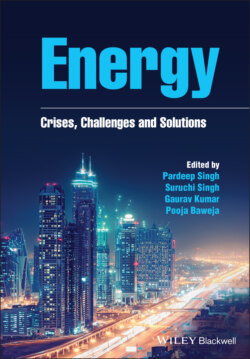Читать книгу Energy - Группа авторов - Страница 65
2.3.5 Bioenergy
ОглавлениеBioenergy is one of the alternative forms of energy derived from biological sources and/or residues i.e. biomass. Thus, source of energy is biomass. Use of bioenergy is classified mainly into two types, traditional/conventional and modern (Gupta et al. 2014, pp. 1–17). Conventional use is the direct utilization of source i.e. biomass (e.g. wood, agricultural waste, traditional charcoal etc.) combustion to obtain energy. Modern use is the indirect use i.e. conversion of biomass using different technologies into biofuels. Apart from biofuels, other recent bioenergy technologies includes bio‐refineries (a range of bio‐products are produced consuming biomass), biogas (obtained via anaerobic digestion of bio‐residues) and wood pellet heating systems. Bioenergy can be stored for a long period as opposed to other renewable energy sources. By 2015, its share in total final energy consumption was nearly 10%, and 1.4% in worldwide electricity production. Approximately, 80% of bioenergy is consumed traditionally in the developing countries i.e. for cooking, space heating, and lighting (Lund et al. 2016, pp. 36–38). In 2019, bioenergy power generation capacity was 124 GW with a 5% growth in the year. Its contribution is roughly 5% in the worldwide renewable generation capacity, and China contributed more than half (3.3 GW) of new capacity added (6 GW) in the same year (IRENA 2020b).
Large‐scale production of biofuels can be achieved when these are produced using agricultural crops, crop residues, agro‐industries wastes, forests residue etc. At present, production cost of biofuels is high, conversion efficiency is low and its cost‐effectiveness is also low compared with other energy sources. To mitigate these issues, scientific community is doing lot of research worldwide. Advances are taking place in technologies for pre‐treatment of lignocelluloses and cost‐effective production method for biofuels with no or minimum by‐products (Lund et al. 2016, pp. 36–38). Bioenergy can significantly contribute in energy sector in the twenty‐first century. It will be a key component for the development of rural areas, agricultural sector and forestry.
